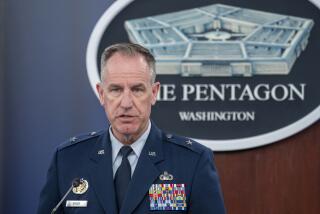U.S. Aids Laos’ War on Unexploded Ordnance
- Share via
NAM SOUANG, Laos — In the mountains and jungles of Laos, the last battle of a secret war is still being fought, 24 years after the final mission of U.S. bombers turned for home.
This time, the victims are peasants, and the combatants, in another irony of the Indochina War, are again U.S. soldiers--15 of them, in civilian clothes, teaching Laotians how to defuse a vast arsenal of unexploded American ordnance that needs only an unsuspecting touch to kill and maim.
For nine years, between 1964 and 1973, U.S. warplanes carried out 580,000 bombing missions over Laos, trying to stop the advance of Pathet Lao guerrillas and the movement of North Vietnamese men and supplies over the Ho Chi Minh Trail.
The campaign was an utter failure: Both Communist groups came to power in 1975.
During the air war--when Washington admitted only to carrying out armed reconnaissance flights over Laos--U.S. planes dropped 2.3 million tons of bombs, making Laos the most heavily bombed country in history.
Laotian officials estimate that between 10% and 30% of the ordnance malfunctioned and did not explode on impact. There are upward of 690,000 tons of cluster bombs, artillery shells and mortar rounds that need only the touch of a farmer’s hoe or a child’s hand to do what they were supposed to do a generation ago.
So last year, with the ordnance having killed or wounded 11,000 Laotians since 1973, the new battle began. Under the auspices of the United Nations Development Program, Laos set up a trust fund to teach villagers about the dangers of UXO, as it is called in official parlance, and to train Laotian demolition experts. Hundreds of young Laotians volunteered.
The Communist government overcame its reluctance to have U.S. military personnel in Laos--Washington had first offered to help in the mid-1980s--and turned an agricultural research center in Nam Souang, 40 miles north of Vientiane, the capital, into a training facility for the Americans.
So far, 374 Laotians have completed the course and taken to the countryside to teach community awareness and start clearing the land.
In one classroom, Staff Sgt. Tim Stoll lectured about blunt- and penetrating-trauma injuries to a group of future medics, who were furiously scribbling notes. And in another, several U.S. Special Forces instructors were teaching map reading to 63 Laotians who will be graduated as demolition experts.
*
Why would anyone volunteer for such a dangerous job?
“Well, the money is good [about $100 a month], and when I go home the village will be proud I have been to school and learned something to help my country,” said Kham Chingphin, 34, who lost 10 of his 13 children to illness and disease.
Although unexploded artillery shells and mortar rounds manufactured in China and the former Eastern Bloc pose danger in Laos, the great majority of the ordnance is U.S. cluster bombs.
In 1975, Laos reported that 1,200 people were wounded or killed in ordnance accidents. Now, that figure is about 200 a year.
The Americans are expected to stay in Laos for two years. The removal program, costing $9.8 million this year, or the equivalent of about five days’ bombing, could run for years.
More to Read
Sign up for Essential California
The most important California stories and recommendations in your inbox every morning.
You may occasionally receive promotional content from the Los Angeles Times.










